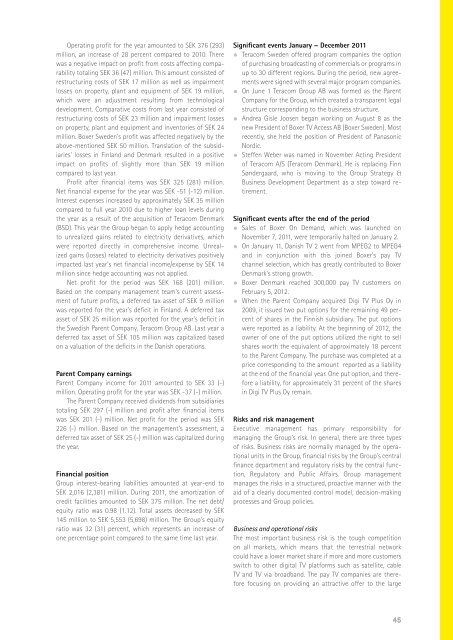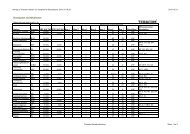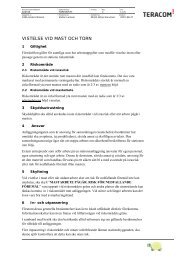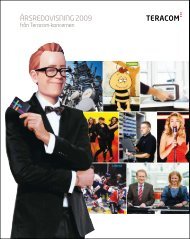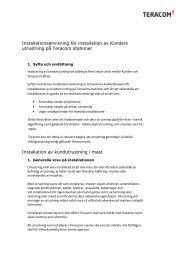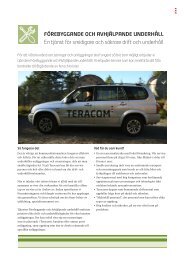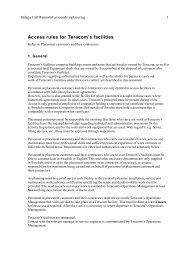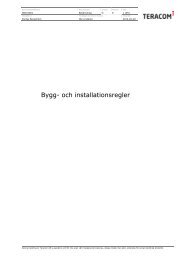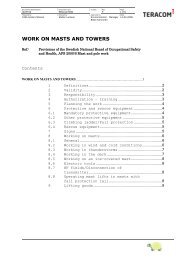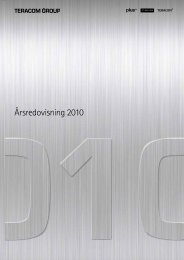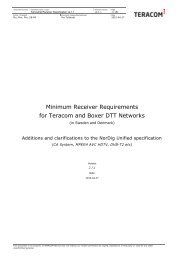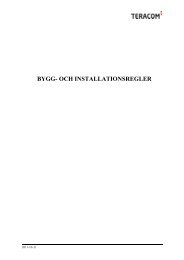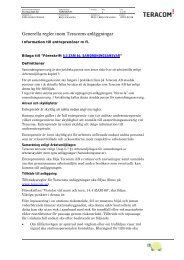Annual and Sustainability Report 2011 - Teracom
Annual and Sustainability Report 2011 - Teracom
Annual and Sustainability Report 2011 - Teracom
You also want an ePaper? Increase the reach of your titles
YUMPU automatically turns print PDFs into web optimized ePapers that Google loves.
Operating profit for the year amounted to SEK 376 (293)<br />
million, an increase of 28 percent compared to 2010. There<br />
was a negative impact on profit from costs affecting comparability<br />
totaling SEK 36 (47) million. This amount consisted of<br />
restructuring costs of SEK 17 million as well as impairment<br />
losses on property, plant <strong>and</strong> equipment of SEK 19 million,<br />
which were an adjustment resulting from technological<br />
development. Comparative costs from last year consisted of<br />
restructuring costs of SEK 23 million <strong>and</strong> impairment losses<br />
on property, plant <strong>and</strong> equipment <strong>and</strong> inventories of SEK 24<br />
million. Boxer Sweden's profit was affected negatively by the<br />
above-mentioned SEK 50 million. Translation of the subsidiaries'<br />
losses in Finl<strong>and</strong> <strong>and</strong> Denmark resulted in a positive<br />
impact on profits of slightly more than SEK 19 million<br />
compared to last year.<br />
Profit after financial items was SEK 325 (281) million.<br />
Net financial expense for the year was SEK -51 (-12) million.<br />
Interest expenses increased by approximately SEK 35 million<br />
compared to full year 2010 due to higher loan levels during<br />
the year as a result of the acquisition of <strong>Teracom</strong> Denmark<br />
(BSD). This year the Group began to apply hedge accounting<br />
to unrealized gains related to electricity derivatives, which<br />
were reported directly in comprehensive income. Unrealized<br />
gains (losses) related to electricity derivatives positively<br />
impacted last year's net financial income/expense by SEK 14<br />
million since hedge accounting was not applied.<br />
Net profit for the period was SEK 168 (201) million.<br />
Based on the company management team's current assessment<br />
of future profits, a deferred tax asset of SEK 9 million<br />
was reported for the year's deficit in Finl<strong>and</strong>. A deferred tax<br />
asset of SEK 25 million was reported for the year's deficit in<br />
the Swedish Parent Company, <strong>Teracom</strong> Group AB. Last year a<br />
deferred tax asset of SEK 105 million was capitalized based<br />
on a valuation of the deficits in the Danish operations.<br />
Parent Company earnings<br />
Parent Company income for <strong>2011</strong> amounted to SEK 33 (-)<br />
million. Operating profit for the year was SEK -37 (-) million.<br />
The Parent Company received dividends from subsidiaries<br />
totaling SEK 297 (-) million <strong>and</strong> profit after financial items<br />
was SEK 201 (-) million. Net profit for the period was SEK<br />
226 (-) million. Based on the management's assessment, a<br />
deferred tax asset of SEK 25 (-) million was capitalized during<br />
the year.<br />
Financial position<br />
Group interest-bearing liabilities amounted at year-end to<br />
SEK 2,016 (2,381) million. During <strong>2011</strong>, the amortization of<br />
credit facilities amounted to SEK 375 million. The net debt/<br />
equity ratio was 0.98 (1.12). Total assets decreased by SEK<br />
145 million to SEK 5,553 (5,698) million. The Group's equity<br />
ratio was 32 (31) percent, which represents an increase of<br />
one percentage point compared to the same time last year.<br />
Significant events January – December <strong>2011</strong><br />
• <strong>Teracom</strong> Sweden offered program companies the option<br />
of purchasing broadcasting of commercials or programs in<br />
up to 30 different regions. During the period, new agreements<br />
were signed with several major program companies.<br />
• On June 1 <strong>Teracom</strong> Group AB was formed as the Parent<br />
Company for the Group, which created a transparent legal<br />
structure corresponding to the business structure.<br />
• Andrea Gisle Joosen began working on August 8 as the<br />
new President of Boxer TV Access AB (Boxer Sweden). Most<br />
recently, she held the position of President of Panasonic<br />
Nordic.<br />
• Steffen Weber was named in November Acting President<br />
of <strong>Teracom</strong> A/S (<strong>Teracom</strong> Denmark). He is replacing Finn<br />
Søndergaard, who is moving to the Group Strategy &<br />
Business Development Department as a step toward retirement.<br />
Significant events after the end of the period<br />
• Sales of Boxer On Dem<strong>and</strong>, which was launched on<br />
Novembe r 7, <strong>2011</strong>, were temporarily halted on January 2.<br />
• On January 11, Danish TV 2 went from MPEG2 to MPEG4<br />
<strong>and</strong> in conjunction with this joined Boxer's pay TV<br />
channe l selection, which has greatly contributed to Boxer<br />
Denmark' s strong growth.<br />
• Boxer Denmark reached 300,000 pay TV customers on<br />
Februar y 5, 2012.<br />
• When the Parent Company acquired Digi TV Plus Oy in<br />
2009, it issued two put options for the remaining 49 percent<br />
of shares in the Finnish subsidiary. The put options<br />
were reported as a liability. At the beginning of 2012, the<br />
owner of one of the put options utilized the right to sell<br />
shares worth the equivalent of approximately 18 percent<br />
to the Parent Company. The purchase was completed at a<br />
price corresponding to the amount reported as a liability<br />
at the end of the financial year. One put option, <strong>and</strong> therefore<br />
a liability, for approximately 31 percent of the shares<br />
in Digi TV Plus Oy remain.<br />
Risks <strong>and</strong> risk management<br />
Executive management has primary responsibility for<br />
managing the Group's risk. In general, there are three types<br />
of risks. Business risks are normally managed by the operational<br />
units in the Group, financial risks by the Group's central<br />
finance department <strong>and</strong> regulatory risks by the central function,<br />
Regulatory <strong>and</strong> Public Affairs. Group management<br />
manages the risks in a structured, proactive manner with the<br />
aid of a clearly documented control model, decision-making<br />
processes <strong>and</strong> Group policies.<br />
Business <strong>and</strong> operational risks<br />
The most important business risk is the tough competition<br />
on all markets, which means that the terrestrial network<br />
could have a lower market share if more <strong>and</strong> more customers<br />
switch to other digital TV platforms such as satellite, cable<br />
TV <strong>and</strong> TV via broadb<strong>and</strong>. The pay TV companies are therefore<br />
focusing on providing an attractive offer to the large<br />
45


